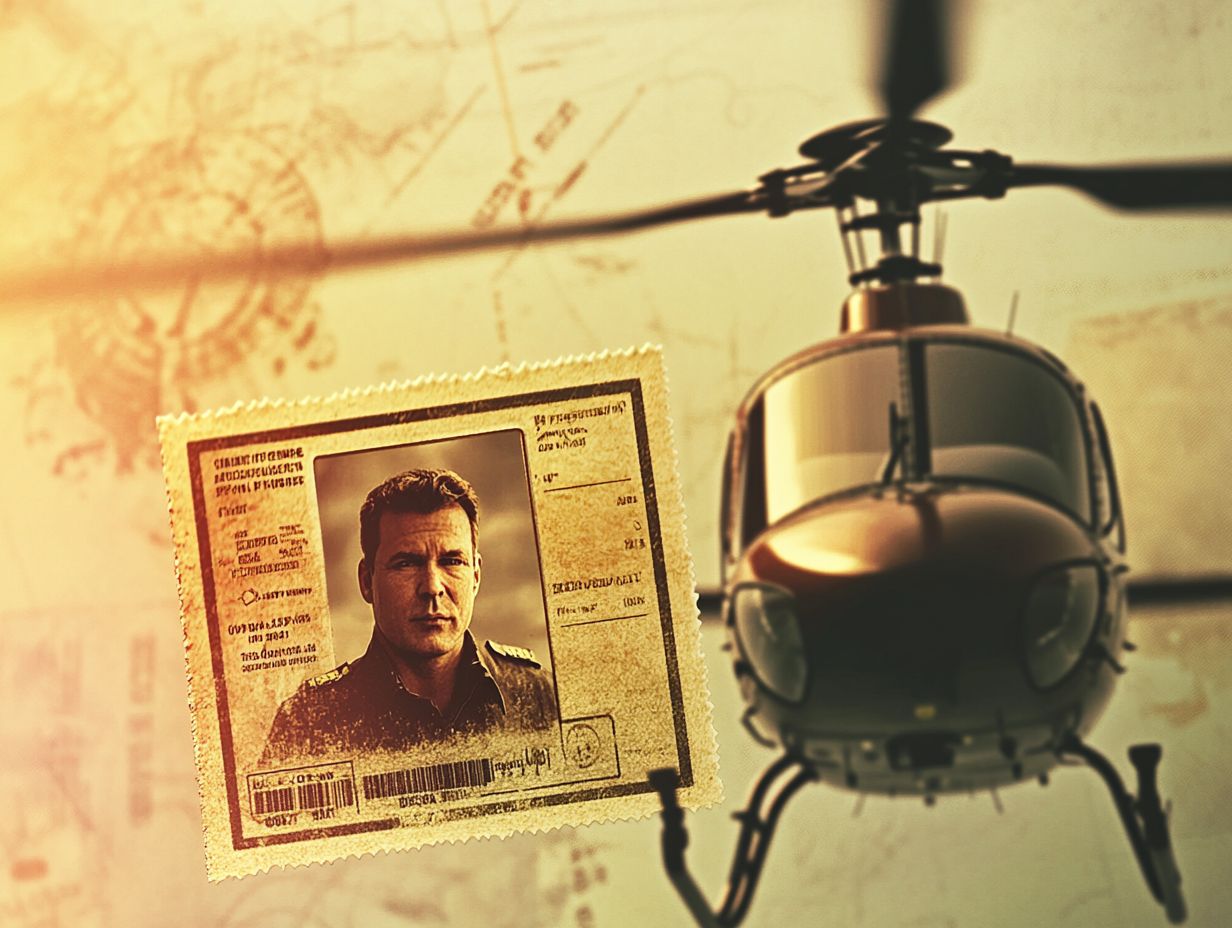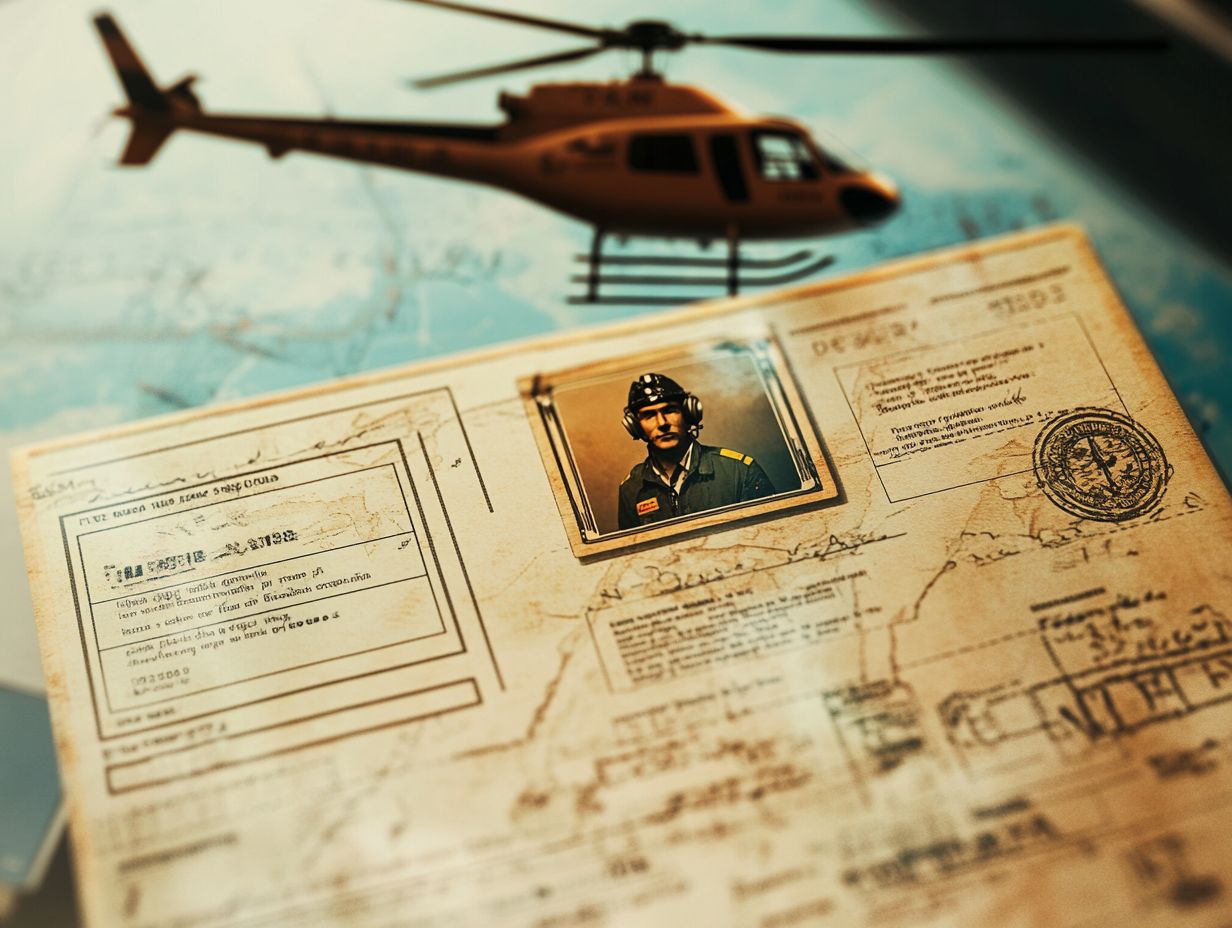If you ever look up and see a helicopter flying, and you think, like, how do you fly one? You are in the right place!
This article shows you the stuff you need to get a helicopter license, like the types you can get—private and commercial—and what you gotta do.
Whether you are dreaming big or thinking about a new job, this info helps you know how to fly!
Key Takeaways:
What is a Helicopter License?

A helicopter license is essential for anyone looking to become a helicopter pilot. It signifies that the individual has completed the required flight training, passed the FAA requirements, and obtained a pilot license that’s recognized for various rotorcraft operations.
With this license, they can operate helicopters for a range of purposes, from private use to commercial activities and even emergency medical services, which can significantly boost their career prospects in aviation.
Acquiring this certification is crucial because it opens up a world of career opportunities within the aviation sector. Whether it’s for aerial surveys, law enforcement, or search and rescue missions, the uses for helicopters are extensive, making this license a valuable asset.
Training programs teach you important stuff about helicopters, like how they work and how to be safe.
The benefits of obtaining a helicopter certificate go beyond just job opportunities; they also build confidence and competence in pilots, enabling them to meet the growing demand for skilled aviation professionals.
Types of Helicopter Licenses You Can Get!
There are various types of helicopter licenses, each designed to match specific flying capabilities and career aspirations.
For example, there’s the Private Pilot License (PPL), the Commercial Pilot License (CPL), and the Airline Transport Pilot License (ATPL). Each of these licenses has its own purpose—some are for recreational flying, while others cater to professional needs or advanced rotorcraft operations.
Of course, each one has its own rules about who can get it and how much it costs.
Private, Commercial, and Other License Types
The primary helicopter licenses are the Private Pilot License (PPL) and the Commercial Pilot License (CPL), each with its own unique purpose and requirements for flight hours and training. The PPL is for those looking to fly helicopters just for the fun of it, while the CPL opens up the possibility of flying for pay, leading to various helicopter jobs in areas like aerial photography and emergency medical services.
To get the PPL, you need to fly about 40 hours with an instructor and some solo time too. They also have to ace a written exam that covers topics like aerodynamics, navigation, and regulations, and then show off their skills in a practical flying test.
On the flip side, snagging a CPL requires a minimum of 150 flight hours and more advanced training, including night flying and performing complex maneuvers. Plus, beyond these essential licenses, individuals can go for specialized certifications like the instrument rating or flight instructor license, which can really boost their qualifications and expand their career options in various aviation fields.
Requirements for Obtaining a Helicopter License

Getting a helicopter license means you gotta meet some FAA rules, like age and medical stuff.
Future pilots gotta finish a training course at a good flight school. They usually start with a student pilot certificate, which helps them get the flight hours and know-how they need.
Getting Ready: Age, Health, and School Stuff
To get a helicopter license, you gotta be a certain age, be healthy, and finish some school stuff.
To get a helicopter license, you gotta be a certain age, healthy, and have some school stuff done. This includes passing an FAA medical exam to secure a medical certificate, which confirms their fitness to fly. Generally, applicants need to be at least 17 years old for a private pilot license and should meet educational standards that set them up for success in pilot training and ground school.
Beyond just the age requirement, candidates have to go through a thorough FAA medical examination that looks at their overall health, vision, and neurological function.
Getting ready for pilot training isn’t just about being fit; you also gotta learn stuff, usually from ground school. This essential education covers a range of topics like aerodynamics, navigation, meteorology, and regulations, all critical for a safe flying experience.
Candidates should use stuff like books, online classes, and flight simulators to help them learn, making sure they understand the ins and outs of flying before they step into the cockpit.
Training and Getting Your License: The Fun Part!
Getting your helicopter license is like a big adventure. It involves rigorous flight training, plenty of interaction with flight instructors, and successfully passing both written and practical exams.
Typically, students enroll in a flight school where they dive into hands-on training, learning all about helicopter controls, rotorcraft systems, and emergency procedures. Along the way, they log the flight hours needed to earn their certification.
Flight Training and Knowledge Tests

Flight training is super important if you wanna get a helicopter license. It combines hands-on flying experience with knowledge tests that evaluate a pilot’s grasp of aviation principles.
Aspirants do both dual flights and solo flights, while getting ready for a written test that covers everything from helicopter systems to navigation techniques and emergency procedures.
This way, people can get a good grasp of both the hands-on and book stuff about flying. As students go through the flight training process, they typically log a certain number of flight hours, which can vary depending on the license level they’re aiming for, ensuring they become proficient in various flight maneuvers.
Concurrently, they reinforce their theoretical knowledge using comprehensive study materials like textbooks, online courses, and flight training manuals that give deep insights into aviation regulations, weather patterns, and aircraft performance.
Plus, utilizing resources like simulation tools and instructional videos can really boost their understanding, helping aspiring pilots visualize flight dynamics and emergency response protocols.
In the end, juggling these elements helps trainees build the confidence and skill set they need for safe and effective helicopter operation.
How Much It Costs to Get a Helicopter License!
Getting a helicopter license can cost a bunch, and it depends on a few things. Things like the choice of flight school, the type of training program, and the number of flight hours needed to nail down that certification all play a role.
Aspiring helicopter pilots need to keep these factors in mind, along with extra expenses for things like equipment, materials, and examination fees, when they’re budgeting for their aviation career.
What Affects the Cost and How to Save Some Cash!
Several factors influence the overall cost of obtaining a helicopter license, including the choice of flight school, the specific training program, and how quickly an individual progresses through their flight hours.
To save money, future pilots can look into group training programs and other ways to cut costs.
They should also think about surprise costs, like maintenance fees and insurance, and save for them.
Using stuff like aviation forums and local pilot groups is a super cool way for them to get advice or help. This can help them find the cheapest ways to get started.
Knowing how to handle money is super important if they wanna fly. Budgeting smart helps them save money and makes things easier to become a pilot.
In the end, the choices they make about their training can really change how much money they can make as pilots later.
Career Opportunities with a Helicopter License

Getting a helicopter license opens up lots of job choices for them in flying stuff.
Since more people want helicopter pilots, they can pick from different job paths like:
- Aerial photography
- Firefighting
- Working in tourism
This significantly boosts their prospects in the aviation industry.
Potential Job Roles and Salary Expectations
Some job roles for helicopter pilots are things like commercial pilots, flight teachers, and medical helpers. Each one has different pay and things you need to do.
For example, commercial pilots can make different amounts of money based on how long they’ve worked and where they work. They can earn good money in tourism or even better in firefighting.
Medical helpers often work in really hard situations, giving important medical help when moving patients. This path can lead to a fulfilling yet demanding career, often accompanied by competitive pay, especially in urban areas.
Qualifications for these roles usually include specific flight hours, valid licenses, and sometimes additional certifications like advanced first aid. These requirements not only affect initial salaries but also play a significant role in long-term career growth and earning potential as these professionals acquire specialized skills and expertise.
Maintaining and Renewing a Helicopter License
For pilots, keeping their helicopter license up to date is super important to follow the FAA rules and keep flying.
This means they gotta take classes, fly a certain number of hours, and have health checks to make sure they’re good to go.
All these steps are super important for keeping flying safe.
Continuing Education and Recertification Requirements
Pilots need to keep learning to meet recertification stuff and follow FAA rules.
Pilots need to engage in continuing education to meet recertification requirements and stay compliant with FAA regulations. This helps them keep their skills and knowledge sharp in the aviation field.
For many, this means completing recurrent training, attending seminars, and staying updated with the latest changes in aviation regulations and practices.
Staying updated is super important, not just to follow the rules but to keep things safe and running well. Helicopter pilots, in particular, have to make renewing their medical certificates a priority since these are critical for ensuring they’re fit to fly.
Lots of pilots pick online classes, workshops, and flight games to learn about emergency stuff, navigation tricks, and new tech in flying.
By jumping into these learning chances, pilots not only get better at what they do but also learn the newest good ways to keep safe and be professional in flying.